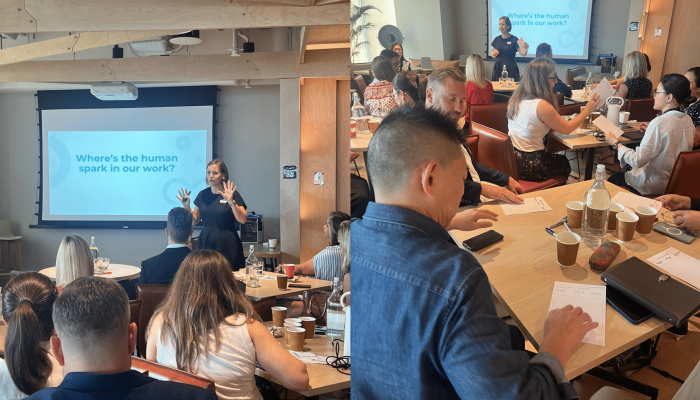The tenure and role of the Chief Marketing Officer has been under the gun for many years. Earlier this year, Korn Ferry released a report saying that the average tenure of the CMO in the US was down 6 months over the last two years and sits, at 4.1 years, as the lowest of all members on the C-Suite. Not surprisingly, the next least secure role is the CIO (Chief Information Officer). All in all, both the marketing and IT departments are on the front line of the digital transformation, to say nothing of digital disruption. How one progresses and/or accelerates the digital transformation process inevitably depends on the company’s size, maturity and talent pool. It also depends on the clarity of purpose and the powerful commitment of the C-suite.
We believe there are three keys to crafting the disruptive mindset. First, the brand and its senior team must have a clear, differentiated and shared North setting. This means establishing a mission that helps to focus resources and, importantly, clear out the nice-to-haves and other tempting, but unnecessary activities. Ideally, this North setting spans both the professional and personal spheres.
Secondly, in a constantly moving landscape, it has never been more important to hire for attitude over competency. For example, take coding. While Javascript may be the most popular code in the market by dint of its longevity, other languages are in greater demand today, including Python, Java, SQL and PHP. The (w)ebb and flow of programming trends means that one cannot bank an entire career on one language. Thus, a programmer may need to learn a new code to stay relevant. In most cases, I believe it is better to hire for the right mindset and cultural fit than a specific expertise.
The third key is to make sure that the full C-suite carries the mantle and exhibits the desired mindset. If each of the members of the C-suite has their own function and responsibility, they all must also have and share, what we describe as, the Chief Mindset Officer responsibility.
Here are the ten characteristics we look for in terms of mindset:
- Relentless curiosity – with an insatiable desire for continuous learning
- Openness – to new ideas, people, systems and platforms
- Networker – connected with all types of people within and without the organization
- Geek Quotient – a healthy appetite to become more techy, even to learn coding…
- Jack of All Trades – moving from a master of one (T-shaped expertise) to a jack or master of many (comb-shaped expertises)
- Empathy – with the heightened ability to think and feel in the shoes of others
- Congruent – a personal sense of purpose that is aligned with company’s
- Hands On – unafraid to roll up one’s sleeves and try things oneself
- Connecting the Dots & People – making sure to look for patterns and to tie the seemingly disparate ideas and people together
- Focused – making sure that one’s actions are tightly aligned with one’s North.
How does one go about developing this mindset? For our new book, Futureproof (Pearson, Sept 2017), my co-author, Caleb Storkey and I, came up with a model for bringing about change in an organization. We call it the PIE model, where actions must happen at three levels: personal, internal (to the company), and external. The key, as a senior marketing executive, is to start oneself, by demonstrating the behaviors and attitude you want to see throughout the organization. For example, if you believe that social media can be a force for your brand, you need to be active in social media yourself, not just delegating it to your Comms team or, worse yet, your ad agency. If you’re not personally aware of the interruptive nature of some of the social media ads, you’ll very quickly agree to the wrong proposition from your ad agency.
Here is some PIE that you can chew on, to start flexing the right mindset muscles:
Personal:
- Re-evaluate your sources of reading and learning. You might want to do a sort of spring cleaning of your daily reading habits. If you haven’t already set up a Flipboard account with your personal keywords, this would be a good starting point.
- If you don’t listen to podcasts, now is a great time to start doing so. It is a supremely effective way to gain new insights while on the go (e.g. walking or jogging…). Here are some great marketing podcasts that I’d recommend: Social Pros (Jay Baer and Adam Brown), Six Pixels of Separation (Mitch Joel) and Duct Tape Marketing (John Jantsch).
- Get geeky and sign up for some introductory coding courses. You can find a good assortment at Udemy. For Javascript, you can try CodeAcademy. Or, if data is an area of interest, check out more here at Khan Academy about the database language SQL.
Internal:
- If your company has switched on to “customer centricity” as a strategic imperative, make it a badge of honor for employees to point out unfriendly elements of your site(s) and user experience. Encourage everyone to buy your product online (or offline as the case may be) and send in reviews.
- If increased agility is a real intention, then make sure that, in the internal communications, everyone has the right to write everyone without need to BCC or CC the world or the immediate superiors. See Elon Musk’s cut-to-the-chase memo to his employees via INC.
- Who are the generalists in your organization? Is their skillset and outlook celebrated and given space to grow? Establish a culture where staff are encouraged to learn a broader range of skills and develop deeper knowledge across multiple areas.
External:
- Be connected to your customers by outlining a centralized list of engagement approaches in one place. Think through all the different disparate tools and platforms that you are using to engage with your customers. Expose yourself to the ways customers are interacting with the brand and re-evaluate how customer satisfaction (better yet customer delight) is being measured across all key channels. Is customer word of mouth a key performance indicator?
- Is your brand’s purpose clear and well communicated? More importantly, to what extent is the brand’s purpose (your North) being lived and exercised within and without the company with consistency and congruency?
- Have you established the right set of external partners? How are you building your partnerships? What is the value exchange you are proposing for each such that they would always want to recommend you?
We hope you will enjoy your PIE and take these steps to heart as part of a plan to make sure you and your brand are futureproofed.
Co-written by Minter Dial, Futureproof, How To Get Your Business Ready For The Next Disruption.
For more information, please see http://futureproof.ly. For pre-orders please see Amazon.com.



